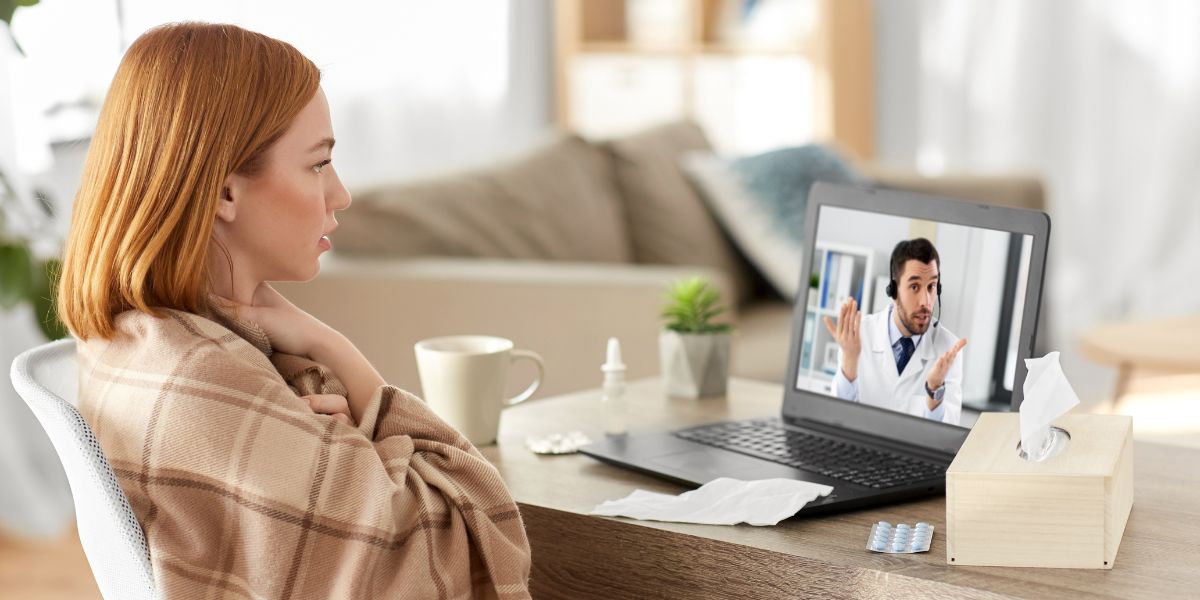One outcome of the COVID-19 pandemic is a dramatic rise in the use of telehealth, where you can connect with patients remotely and removing the need to come in to the office for many types of visits. While virtual appointments are great, there are some things to take note of as a physician to ensure you’re providing the best care for your patients over a video call.
Keep reading for insights on how you can improve the way you conduct telehealth visits, where the challenges are, and when it’s better to have the patient in front of you.
When to Have the Patient in Front of You
You need to have a patient in front of you to perform something hands-on for diagnosis or treatment. Obviously, as a physician, you can’t treat a laceration with sutures or apply a cast to a fracture via a webcam. It would also be difficult to accurately check for numbness in a diabetic patient or joint stability after an injury without the help of someone qualified to perform necessary hands-on testing.
However, remote diagnostic capabilities and even treatment capabilities are improving every day, and the amount of examinations that can be performed remotely is growing every year. We are also able to get a lot more patient generated data about their symptoms and daily experiences through apps and remote monitoring technology.
Challenges of Providing Care When the Patient Isn’t in the Room
Technological inadequacies are the number one challenge that arise in the practice of telehealth. This can come in the form of low-quality equipment, like a suboptimal smartphone camera, or a poor connection on the cellular network or wifi.
Another big challenge you may face is visualizing subtle changes that the patient is describing in the affected region. This can be due to a variety of factors, but it is typically related to poor lighting or a bad internet connection. When you can’t see something that is important — or even worse — when you can’t see or hear the patient clearly due to a faulty connection, this really impairs the practice of medicine.
How to Address the Challenges of Caring for a Patient Remotely
To be successful in delivering care via telehealth, you must create an environment that fosters open and clear communication above all else. 85% of getting an accurate diagnosis relies on taking a thorough and accurate history, and telehealth is the perfect medium for fostering communication when utilized correctly.
1. Set up your environment for success and reduce distractions
Your home office needs to be reflective of the safe space you are creating for healing. Your desktop and space should be free of all external distractions (phones, alerts on your computer screen, other open tabs on your browser, etc.), and your mental state should be cleared of internal distractions before you start interacting with a patient.
Your patient may never see everything going on behind the screen in your home office, but they will feel your presence or lack thereof during the interaction. If you do not honor your patients by creating this space for them, they will not invest in their relationship with you and their health will not improve.
2. Listen to more than the direct content of what the patient is telling you
Patients will convey indirect emotional content with their facial expressions, body language, and tone. When you tune into how your patient is feeling and share how you are feeling during the interaction, this fosters trust and builds the relationship. It is a fundamental human need to feel seen, heard, and validated, and reflecting on a patient’s emotional state is key to forming long-term connection, especially when meeting and delivering care remotely.
3. Consider appropriate times to respond verbally, but otherwise use your body language to express your interest in the content of the conversation
Look for cues that the patient is finished speaking and follow their lead. Do not just follow your own agenda. This avoids situations where you have miscommunication or the need to repeat yourself. You will also learn more about how the symptom presentation is affecting the patient as a whole person.
4. Understand that digital health technology is a tool, just like a stethoscope
Make sure that you check your equipment weekly — if not daily — to ensure you always have a clear connection and that you have time to adjust when needed. Always have a back-up method for accessing the internet, like a hotspot, for times when your wifi may be cut off unexpectedly. Make sure you communicate with the patient at the beginning of the meeting, and always have a plan for unexpected connectivity issues — either you will call them back or they will call you — so they aren’t left hanging in the middle of an appointment if either of you lose connectivity.
5. Empower patients with a suite of tools to use following the interaction
Having a repository of educational materials that engage patients in their own medical care and empower them to make progress towards their goals is key. These materials should also be easy to understand (5th grade reading level) and, when possible, in the patient’s native language.
Benefits of Telehealth & Remote Care
Telehealth allows you to reach your patients exactly where they are. It takes away the geographic constraints that often limit connection in medicine and provides greater accessibility for those with limitations in movement.
The ability to connect with patients and spend more time in communication also creates stronger relationships with your patients and improves participatory decision making, which leads to improved treatment plan adherence and better long-term health outcomes for patients. Overall, people state that they prefer to connect with their private physician during times of stress and illness, and having a strong telehealth program for your practice can improve your patients’ lives and health by offering that connection and availablility.
Tools for remote patient monitoring (RPM) in-between visits help capture daily patient vital signs. RPM can be instrumental for you when helping patients stay on track with their health goals because they also meet regularly with a health coach to review their readings and their progress. That way, when they do meet with you, everyone already has a clear view of what has been happening since the last visit. Anything you add to the patient experience that is high-tech, should be complemented by a high-touch component to improve patient experience and engagement.
What Patients Should Know to Make the Most of a Virtual Appointment
Patients need to make sure they can communicate clearly with you during the visit, so it’s best if they can limit distractions in their space and make it as private as possible.
If you’re not the patient’s regular doctor, make sure you gather as much about their history as possible before the visit and encourage patients to be very thorough in filling out any intake questionnaires.
Ask questions during the visit to engage with the patient. Make it known that you want to help them and be a partner in their care, and that if they don’t understand something, to ask their own questions. Remind them that no question about their health or care is a bad question! The more they understand, the better their outcomes will be.
Looking Forward to The Future of Telehealth
There are lots of technologies in development regarding healthcare and telehealth, like AR and VR. While new technology can be exciting, it needs to demonstrate usefulness in improving health and have a significant personal engagement component. More than AR and VR, technology that makes care interoperable (allows you to transfer your health record between care locations) will be critical going forward in the industry.
For too long, we have gotten our care delivered in siloes where your health information is not truly portable. When you do request records, the data is just dumped as a large PDF file —which you often won’t have the time to thoroughly review it. New technology is being built that will parse the data into a format that is easily transferable and readable so that you or any physician can help any patient at any time.
One Concern for the Future
During the pandemic and the years since, non-HIPAA compliant technology has been used to facilitate telehealth. This is due to specific exemptions that prevented physicians from being prosecuted for a HIPAA violation if they use FaceTime, Facebook Messenger, etc. for telehealth visits at the height of the crisis. However, securing sensitive data should be a priority for your practice, and investing in HIPAA complaint digital tools is crucial — these exemptions likely will not last forever.
Using platforms like FaceTime and Messenger is also concerning because these companies are not known to be good stewards or protectors of data. People should be concerned about these companies having access to private health information. Make sure you use HIPAA compliant software for your visits and that you can ensure (as much as possible) that patients’ health data is securely stored.




